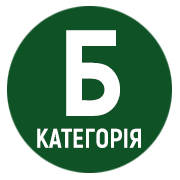LEGAL ASPECTS OF COUNTERING INFORMATIONAL VIOLENCE AGAINST CHILDREN
Abstract
The article examines the current state of legal regulation of social relations regarding the distribution of information products, which negatively affects the physical, mental, and moral condition of a child, the justification of the need to improve the system of appropriate legal regulation, and the development of practical recommendations for reforming legislation as a separate institution of the general system of countering informational violence. The essence of the concept of informational violence in the narrow and broad sense is considered. It was determined that a mandatory feature of the legislation of democratic countries is the establishment of strict restrictions and prohibitions on the distribution of information among children and adolescents that "destroys morality" and "violates their well-being". Among the mechanisms for the implementation of relevant restrictions and prohibitions provided for by law, the following are established: examination of information products, introduction of age classifications and restrictions on the time of broadcast of "children's" and "adult programs", development of registers, creation of special control and supervision bodies, establishment of strict measures of responsibility for illegal circulation of information products. It has been established that a number of laws have been adopted in Ukraine to prevent and combat violence against children in the family, in educational institutions, and to prevent sexual violence. At the same time, informational violence and violence perpetrated with the help of informational communication means are not mentioned in the specified regulatory legal acts. Therefore, it is proposed to introduce amendments and additions to the Law of Ukraine "On the Protection of Public Morals" and other normative legal acts, to improve the mechanism of bringing to legal responsibility persons guilty of distributing informational products that can cause informational violence against a child; carrying out preventive explanatory work both with parents and with the child; development of recommendations for the media community to prevent the distribution of information products that may harm the moral health of a child. The problem of violation of children's rights is extremely complex, and it must be solved by comprehensively involving law enforcement agencies, scientists, and public organizations in cooperation. Only the awareness that everyone's indifference is the key to the formation of a morally stable young generation can serve as a condition of faith and hope for the strengthening and preservation of public morality in the future.
References
2. Конвенція про права дитини / Права людини. Міжнародні договори України, декларації документи [упоряд. Ю. К. Качуренко] К. : Юрінформ, 1992. С. 123 – 146.
3. Данильян О.Г., Дзьобань О.П. Інформаційне насильство: сутнісні проблеми. URL.: http://www.rusnauka.com/3_anr_2011/philosophia/2_78843.doc.htm
4. Василевич О.Г. Інформаційне насильство як соціальний феномен. URL.: http://eprints.zu.edu.ua/2024/1/22.pdf
5. Самчинська О.А., Фурашев В.А. Інформаційне насильство, інформаційна маніпуляція та пропаганда: поняття, ознаки та співвідношення. Інформація і право. № 1(36). 2021. С. 55-65.
6. Кримінальний кодекс України. Відомості Верховної Ради України. –2001. № 25-26. Ст 131.
7. Про захист суспільної моралі. Закон України від 20.11.2003 р. № 1296-IV: станом на 03 бер. 2022 р. URL: https://zakon.rada.gov.ua/laws/show/1296-15#Text (дата звернення: 11.06.2022).
8. Новицька Н.Б. Правові основи захисту дітей від негативного впливу інформаційного середовища. Правова інформатика : науковий журнал з питань правової інформатики, інформаційного права та інформаційної безпеки. 2009. № 4(24). С. 37-41.



